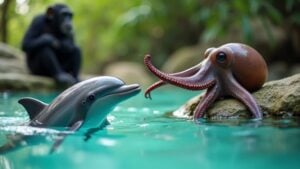As one examines brain-to-body ratios across species, the results defy expectations. Tiny ants, weighing less than a gram, boast brains making up 12% of their mass—a figure dwarfing even humans’ 2%. Shrews follow closely, their rapid metabolisms demanding oversized brains for swift decision-making.
This challenges assumptions linking intelligence solely to absolute brain size, suggesting neural density and efficient wiring matter more. The real surprise? Some of nature’s smallest creatures pack the most cerebral power per ounce, reshaping how we define smarts in the animal kingdom.
The Surprising Leader in Brain-to-Body Size Ratio
As ants pertain to brainpower relative to body size, ants defy expectations. Despite their tiny body size, species like Brachymyrmex ants have a brain-to-body mass ratio as high as 12%, one of the largest in the animal kingdom.
Such a high brain-to-body ratio suggests intelligence isn’t solely about raw brain mass but also brain architecture. These ants display advanced problem-solving skills and intricate colony behavior, proving that brain size alone doesn’t dictate cognitive ability.
Their disproportionately heavy brain weight, compared to their minuscule bodies, supports complex social interactions and navigation. This counters the assumption that bigger brains always mean smarter creatures. Instead, evolution favors efficient brain-to-body ratios, allowing ants to thrive through teamwork and adaptability, all powered by a surprisingly dense neural system.
How Brain Architecture Affects Cognitive Abilities
Ever marveled why some animals outsmart others despite having smaller brains? Brain architecture plays a bigger role than sheer size. The cerebral cortex, responsible for complex contemplation, and neuron density—how tightly packed brain cells are—determine cognitive abilities more than total brain mass.
Species like primates have larger frontal lobes, linked to problem-solving and curiosity, giving them an edge. Evolutionary adaptations shape brain structure, favoring efficient neural connections over bulk. The encephalization quotient, measuring brain-to-body ratio relative to expected size, reveals smarter species often prioritize quality over quantity.
For instance, humans pack high neuron density into a modest-sized brain, enabling advanced reasoning. Brain structure, not just size, dictates intelligence, proving cleverness comes from how brains are constructed, not just how big they are.
Unexpected Patterns in Mammalian Brain Evolution
Mammalian brain evolution didn’t follow a straightforward path—some twists shocked scientists. Research from the University of Arizona revealed that brain-to-body size ratios shifted dramatically after mass extinction events, reshaping mammalian brain evolution.
Contrary to Haller’s rule, which suggests smaller animals have proportionally larger brains, some lineages evolved bigger brains independently of body size. Climate shifts 23-33 million years ago spurred the development of large brains in dolphins and primates, but not always due to intelligence evolution. Instead, relative brain size sometimes grew because body size shrank.
These unexpected patterns challenge old assumptions, showing brain size changes often linked to survival pressures rather than cognitive leaps. The findings highlight how complex and unpredictable mammalian brain development truly was.
Why Smaller Animals Often Have Relatively Larger Brains
Many small animals pack surprisingly big brains relative to their tiny bodies, a quirk of nature that helps them stay quick and adaptable. The relationship between brain and body size isn’t straightforward—smaller animals often need larger brains relative to body size to manage complex tasks. Neurobiology suggests this brain-to-body ratio supports faster reflexes, better sensory processing, and adaptability. Cold-blooded vertebrates, with slower brain metabolism, usually have smaller brains than similarly sized warm-blooded species. The cerebral cortex, essential for cognition, also plays a role in this balance.
| Animal Type | Brain Size | Relative to Body Size |
|---|---|---|
| Shrew | Small | Very Large |
| Human | Large | Moderate |
| Frog | Tiny | Small |
| Bird (e.g., crow) | Small | Large |
| Fish | Tiny | Very Small |
This table highlights how brain size varies across species, showing why smaller animals often need proportionally larger brains.
Debunking Common Myths About Brain Size and Intelligence
The idea that bigger brains mean smarter creatures is a myth that doesn’t hold up under scrutiny. While the sperm whale has the largest brain of any animal, its intelligence doesn’t surpass that of dolphins or humans, who have smaller brains but higher brain-to-body ratios.
Ants, despite their tiny brain size, have one of the largest brain-to-body ratios, allowing complex behaviors. Gorillas and orangutans, though close in body size to humans, have markedly smaller brains, yet display remarkable problem-solving skills. Even domesticated animals, which often have reduced brain sizes compared to wild relatives, show adaptability and learning abilities.
Intelligence depends on neural complexity, not just brain size, debunking the oversimplified link between the two.
Conclusion
The findings reveal that brain size isn’t the sole measure of intelligence—ants and shrews prove big things come in small packages. Their remarkable brain-to-body ratios show efficiency matters more than sheer mass, debunking the myth that bigger always means smarter. As the old saying goes, “It’s not the size of the dog in the fight, but the size of the fight in the dog.” Nature’s surprises remind us that cleverness thrives in unexpected places.


